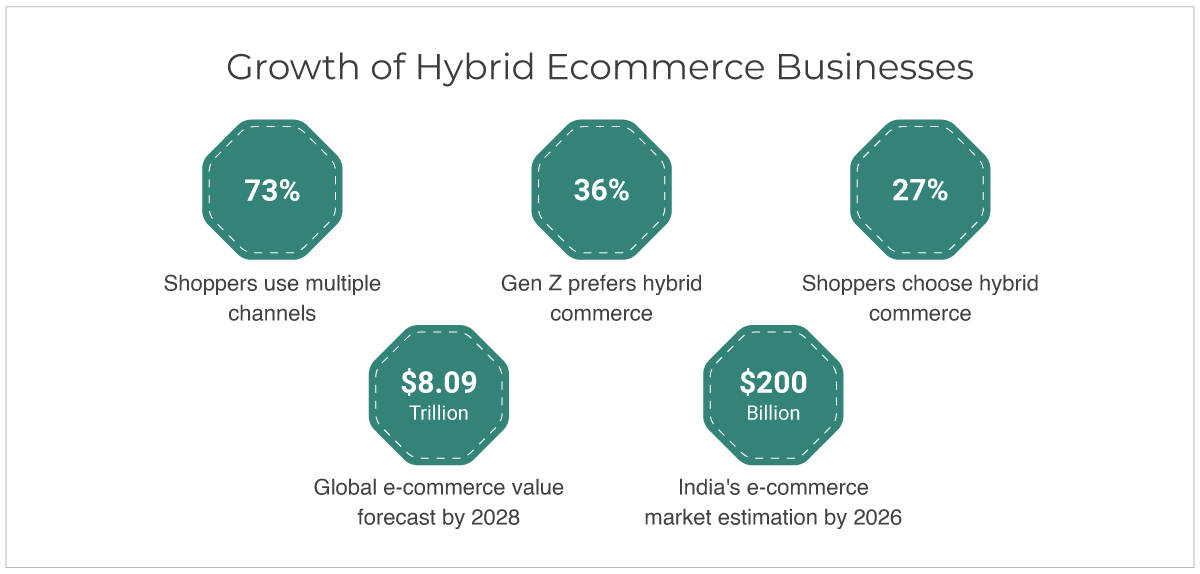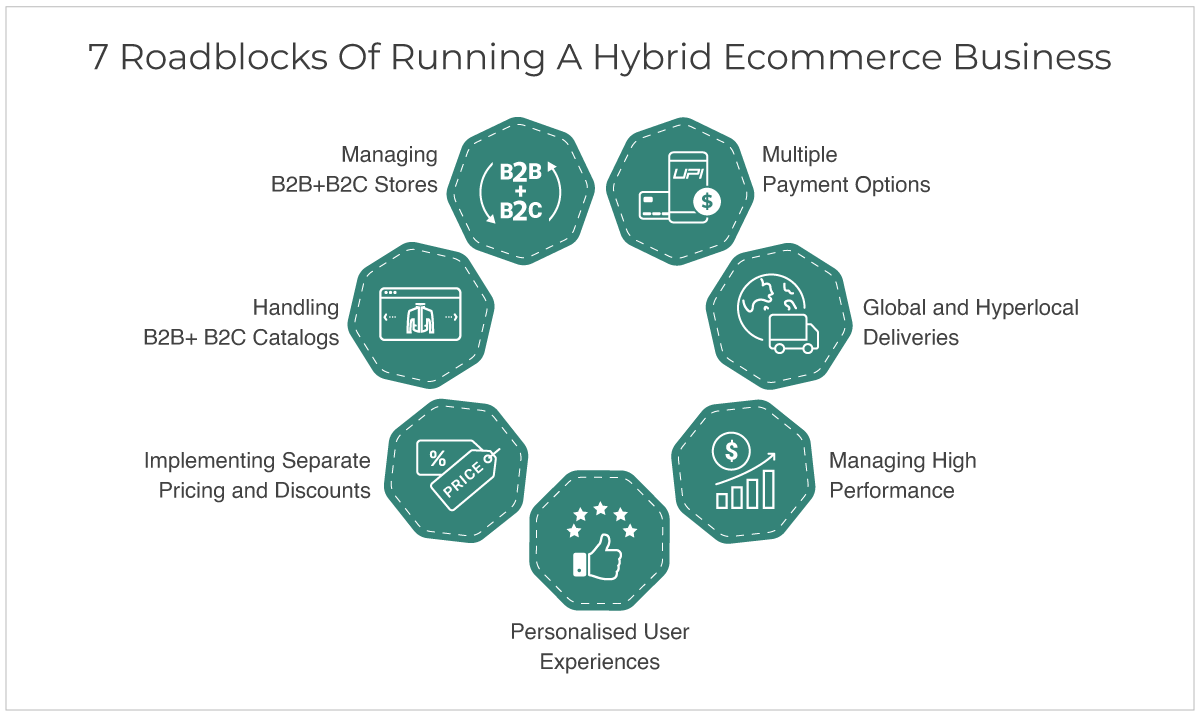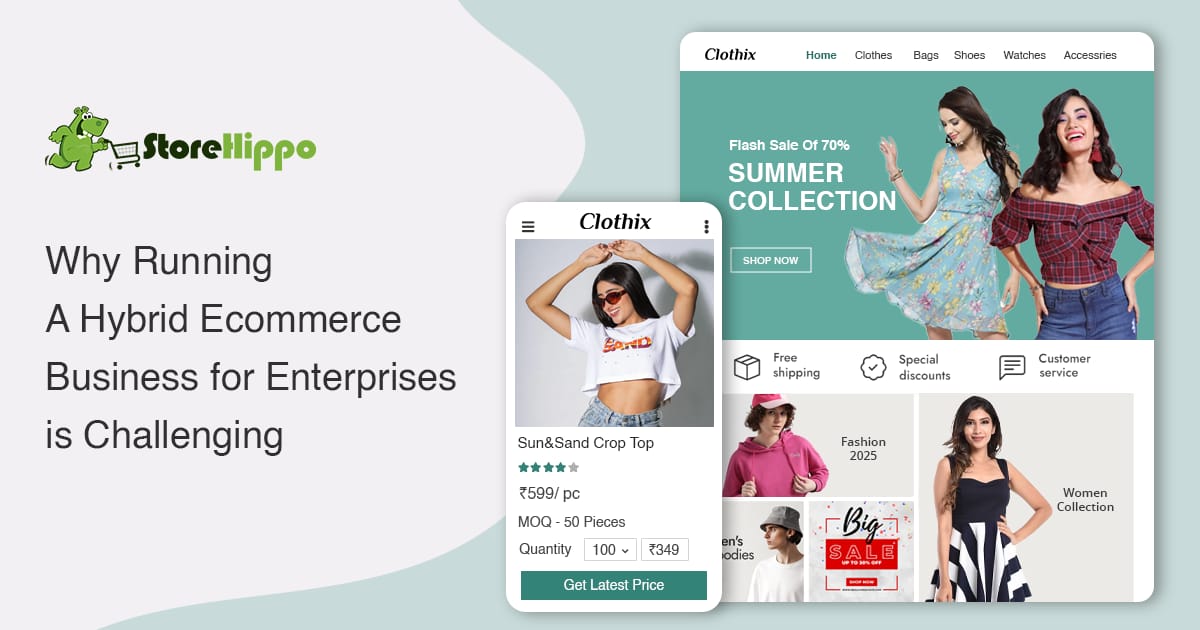Thinking of switching to a hybrid ecommerce business model?
Well, you're not alone.
As enterprise brands look to tap into both B2B and B2C markets, hybrid models have become the go-to strategy.
Wonder why?
Well, to name a few, broader reach, higher revenue potential, and better customer experiences across the board, etc.
But while hybrid e commerce sounds great on paper, the reality of running such a business comes with a fair share of challenges.
So, what’s making it tough for enterprises to go hybrid smoothly?
Is it the complexity of managing multiple customer types?
Or the chaos of syncing operations, logistics, and marketing across B2B and B2C channels?
Maybe it’s your enterprise ecommerce platform’s tech stack that simply wasn’t built to support this level of flexibility.
Whatever the roadblock, one thing’s clear, running a hybrid ecommerce business isn't just about doing more.
It’s about doing things smarter.
Table of Contents
- Hybrid E Commerce: Challenges and Solutions
- 7 Challenges of Running A Hybrid Ecommerce Business for Enterprises
- 1. Building and Managing Distinct Storefronts for B2B and B2C
- 2. Handling Bulk B2B and Extensive Updates of B2C Catalogs
- 3. Implementing Separate Pricing Rules and Discounts
- 4. Creating Personalised User Experiences
- 5. Ensuring Robust Performance at Scale
- 6. Managing Global and Hyperlocal Deliveries
- 7. Integrating Diverse Payment Methods
- Conclusion
Hybrid E Commerce: Challenges and Solutions
Running a hybrid ecommerce business where B2B and B2C operations coexist can present unique challenges. From managing separate buyer journeys and pricing models to handling bulk B2B catalogues alongside fast-moving B2C inventories, the complexity can quickly spiral. Personalising experiences, automating workflows, and ensuring smooth order fulfillment across both segments require robust, flexible systems. Many platforms struggle to support such dual functionality without compromising performance or control. The solution lies in choosing a hybrid ecommerce platform that’s purpose-built for hybrid enterprise needs.
Here are a few statistics suggesting the growth of hybrid business models:

- 73% of retail consumers use multiple channels to shop
- 36% of Gen Z shoppers identified hybrid commerce as their primary choice, highlighting its growing popularity
- 27% of shoppers listed hybrid commerce as their preferred method, indicating a significant adoption rate
- $8.09 trillion is the forecasted value of global e-commerce sales by 2028
- $200 billion is the estimated size of India's e-commerce market by 2026
Source: Statista, TheGood.com
With today’s shoppers not sticking to just one channel, the shift in behaviour has propelled hybrid e commerce from a niche strategy to a mainstream expectation. Well, it's not just Gen Z that's driving this change; consumers across generations are blending their digital and in-store experiences for speed, convenience, and confidence in their buying decisions.
With ecommerce sales accelerating at a global level, brands that embrace hybrid commerce are better positioned to meet customers wherever they are.
7 Challenges of Running A Hybrid Ecommerce Business for Enterprises
Running a business that serves both B2B and B2C customers on a single hybrid ecommerce platform can be highly rewarding, but also incredibly complex. Balancing bulk B2B orders with fast-paced B2C demands often leads to logistical and technological challenges. You therefore need the right tools for catalogue management, personalisation, and workflow automation can quickly become overwhelming. Overcoming these challenges requires a robust ecommerce platform built to easily support dual business models.

Let us uncover the 7 most common challenges enterprises face when running hybrid ecommerce models, and explore how overcoming them can unlock powerful growth opportunities.
1. Building and Managing Distinct Storefronts for B2B and B2C
Managing both B2B and B2C operations on the same platform often creates friction due to their contrasting customer journeys. While B2B customers demand features like bulk ordering, negotiation workflows, and complex GST invoicing, B2C buyers expect a seamless, fast, and intuitive checkout experience. Trying to merge these distinct buying needs into a single storefront can result in a compromised user experience for both segments. You must also ensure brand consistency while maintaining tailored features for both retail and wholesale customers, which is undoubtedly difficult without a hybrid enterprise ecommerce platform that supports customer-specific experiences.
StoreHippo ecommerce solutions come with multi-store functionality that helps you create multiple sub-stores for your enterprise brand. Whether you need to create a wholesale B2B portal or a sleek B2C website, you can create multiple stores and manage them from a common admin dashboard. You can create unique domains and URLs for both retail and wholesale sub-stores. With the built-in design theme library from StoreHippo, you can also create unique store designs and customise both retail and wholesale storefronts according to your audience's needs. The flexibility of the hybrid ecommerce platform ensures that customer expectations are met without complicating backend management.
2. Handling Bulk B2B and Extensive Updates of B2C Catalogs
A hybrid ecommerce business typically manages two very different types of product catalogues. B2B catalogues are vast, often including thousands of SKUS, detailed technical specifications, custom pricing, and bulk order variants. In contrast, B2C catalogues are frequently updated, seasonal, demanding quick turnaround times and real-time changes. Manually managing both can result in errors, outdated listings, and inventory mismatches, affecting sales performance, especially when catalogue complexity increases as businesses scale. Without automation and structured workflows, handling dual catalogs on an enterprise ecommerce platform can drain internal resources and slow down business responsiveness.
With StoreHippo, you need not waste hours replicating and matching product descriptions across massive catalogs. You can move fast with StoreHippo AI Ecommerce solutions. You can seamlessly upload product images and let AI instantly generate optimized, high-converting product descriptions and titles. With AI, you can add or edit huge catalogues, update thousands of listings in minutes, and create conversion oriented product details. StoreHippo helps instantly generate SEO-rich, conversion-focused product content from just an image. Whether you are running a large B2B catalog or refreshing your dynamic B2C listings, you also get full flexibility to fine-tune AI-generated content to match your brand voice and marketing strategy.
3. Implementing Separate Pricing Rules and Discounts
Pricing strategies vary drastically between B2B and B2C models. B2B businesses often rely on negotiated pricing, volume-based discounts, and credit terms. On the other hand, B2C pricing is driven by fixed product rates, seasonal promotions, and flash deals. In a hybrid e commerce environment, trying to apply one-size-fits-all pricing or discount leads to chaos, causing confusion for customers, miscalculations in invoicing, and ultimately lost revenue. Without a flexible pricing system, it becomes nearly impossible to manage discounts, promotions, and pricing tiers accurately across different customer types. Enterprise businesses need a solution that can handle dynamic pricing logic without compromising speed or control.
StoreHippo simplifies complex pricing models with its tiered pricing and rule-based discount engine. With StoreHippo’s inbuilt tiered pricing, you can quickly implement and manage multi-pricing on your marketplace. You can quickly set-up multi-level prices like volume-based pricing, rule-based prices, min-max quantity-based pricing, customer segment or customer-specific pricing to attract B2B buyers from various segments. You can easily define pricing rules based on customer type, order volume, location, or purchase history. The B2B buyers on your marketplace can automatically see negotiated or bulk pricing, while B2C shoppers view public-facing retail prices. With the built-in powerful discount engine from StoreHippo, you can also implement multi-level discounts on your hybrid ecommerce marketplace like order-based, brand-based, vendor-based, product-based, etc.
4. Creating Personalised User Experiences
Personalisation is no longer a nice-to-have feature, it's a critical element of modern ecommerce. B2B buyers expect experiences tailored to their purchase history, roles, and company profiles, including features like account-specific catalogues, negotiated pricing, and order approval workflows. Meanwhile, B2C shoppers want personalised product recommendations, marketing content, along with a smooth browsing experience. The challenge for hybrid ecommerce businesses lies in managing these two distinct personalisation needs on the same platform. Without built-in tools to deliver customised journeys for each audience, customer engagement suffers and conversions drop.
Built on MACH architecture, StoreHippo B2B ecommerce solutions give you better creative control and agility to implement multi-level personalisations on your hybrid marketplace. With StoreHippo’s built-in features like drag-and-drop design tools, pricing overrides, discount engine, multilingual, multi-currency, etc. you can seamlessly implement multi-level personalisations on your marketplace. The price override feature helps you offer personalised product prices based on customer segments and locations for your B2B audiences. With the built-in discount engine from StoreHippo, you can create personalised discounts and offers for your B2C buyers. You can also send out personalised notifications with the PUSH notification feature from StoreHippo hybrid ecommerce platform and recover abandoned carts seamlessly.
5. Ensuring Robust Performance at Scale
Enterprises operating a hybrid business model often struggle with performance bottlenecks. A spike in B2C traffic during festive sales or the need to process large B2B transactions can overload traditional platforms. These performance issues lead to slow page loads, transaction failures, and poor user experience, ultimately affecting business credibility. As operations scale, the need for a robust infrastructure that can handle heavy loads, concurrent users, and high transaction volumes becomes critical. Without the right technology backbone, hybrid ecommerce businesses risk downtime during peak periods and reduced customer satisfaction.
StoreHippo enterprise ecommerce platform comes to your rescue with its secure and inherently scalable cloud-native infrastructure. Built on the most advanced technology stack, StoreHippo offers peak load tolerance with 99% uptime. StoreHippo supports the growth of your hybrid business so that you do not have to worry about the platform scalability. The elastic scalability of the cloud-native infrastructure along with the auto-provisioning of servers ensures that enterprise brands need not worry about peak load tolerance or growing exponentially. StoreHippo offers unmatched flexibility, inherent scalability, and superfast performance for your marketplace.
6. Managing Global and Hyperlocal Deliveries
A hybrid ecommerce business must navigate two very different delivery expectations. B2C customers often expect same-day or next-day hyperlocal deliveries with real-time tracking, flexible delivery slots, and live updates. In contrast, B2B orders may involve large shipments, bulk logistics planning, scheduled deliveries, etc. Managing both within a single logistics workflow can be a major challenge. Such diversity in delivery models can strain operations, especially when legacy systems lack flexibility and often require third-party integrations. Without real-time sync across inventory, shipping partners, and fulfillment workflows, enterprises risk delayed deliveries, higher shipping costs, and reduced customer satisfaction. Balancing hyperlocal speed with bulk shipment accuracy requires an enterprise ecommerce platform and advanced logistics strategy.
StoreHippo hyperlocal ecommerce solutions help you offer quick deliveries for your customers with its 30+ pre-integrated shipping and logistics solutions. You can seamlessly create multiple stores for different vendors and their warehouses based on their location and leverage the benefits of optimised hyperlocal deliveries. You can onboard multiple global vendors with the seamless multi vendor solutions from StoreHippo. You can also manage your own fleet of delivery boys using the built-in delivery boy solution. With StoreHippo ecommerce solutions, you can also save big on logistics costs by routing the order through the nearest distributor/warehouse from the client location.
7. Integrating Diverse Payment Methods
One of the biggest friction points in hybrid ecommerce lies in payments. B2C buyers expect instant payment options, like UPI, wallets, cards, while B2B clients often rely on credit purchases, invoicing, and deferred payment options. Managing both on a single platform without error or disruption can become a major hurdle. If the checkout process lacks flexibility or fails to accommodate segment-specific payment preferences, it can lead to abandoned carts and poor customer experience. The challenge is even bigger at scale, where enterprises must ensure security, compliance, and reconciliation across various payment flows. A hybrid model demands a highly adaptable and intelligent payment infrastructure.
StoreHippo hybrid ecommerce platform offers a full range of digital payment solutions with 60+ pre-integrated domestic and international payment gateways. You can integrate with more than one payment solution to create a frictionless payment process for both audience groups. Multiple payment options enable your customers to choose their preferred payment method from options like COD, digital payment, card payments, store credits, wallets, etc. You can also offer personalised payment gateways based on your customers' location on your marketplace website with StoreHippo.
Conclusion
Running a hybrid ecommerce business at the enterprise level can be challenging. The dual demands of serving both B2B and B2C customers introduce layers of complexity across every function, from storefront design and catalog management to pricing, logistics, and payments. Without the right hybrid ecommerce platform, even well-established hybrid brands can struggle to maintain consistency, performance, and personalisation across diverse customer segments.
Enterprises therefore need a future-ready enterprise ecommerce platform that’s built to support the agility, scalability, and personalisation needs of hybrid business models. StoreHippo makes it possible to manage the intricacies of hybrid ecommerce with a unified, flexible tech stack designed for modern enterprise use. StoreHippo comes with a host of features and tools to help you keep up with the latest ecommerce trends and carve a niche for your hybrid enterprise brand. The 300+ enterprise-grade features, inherent flexibility, and unmatched scalability help you build tailor-made solutions that can cater to diverse audience segments.
Ready to build your hybrid e commerce business marketplace with StoreHippo? Explore a wide range of features by starting your 14-day free trial now.


